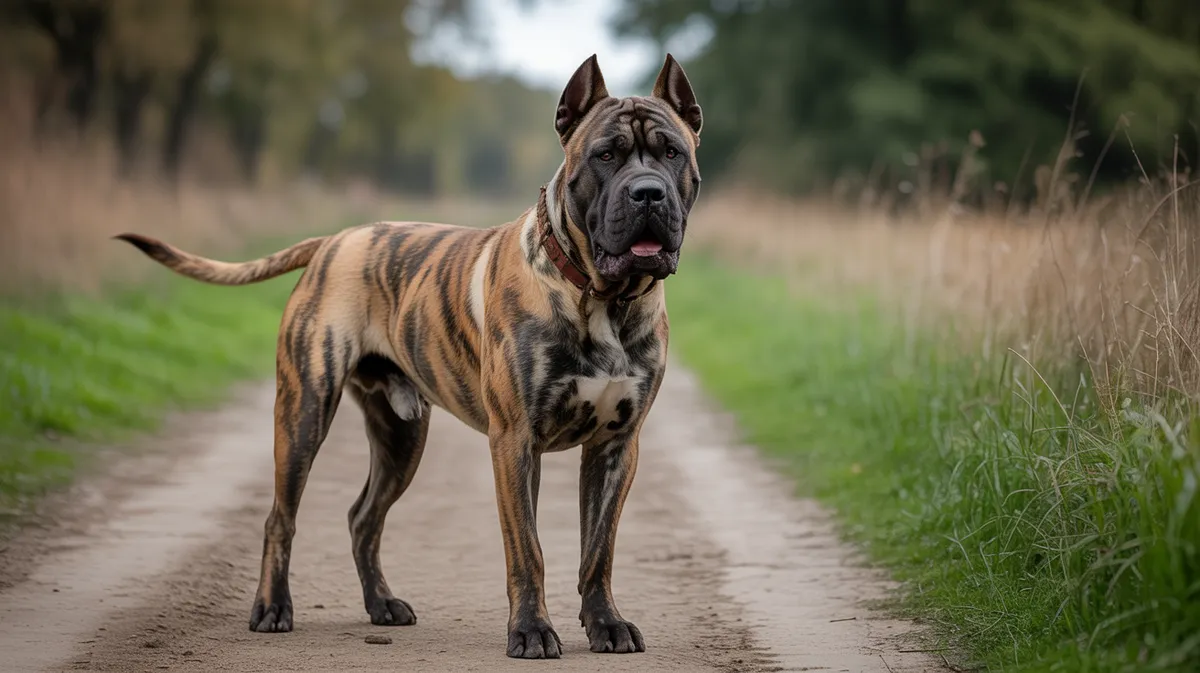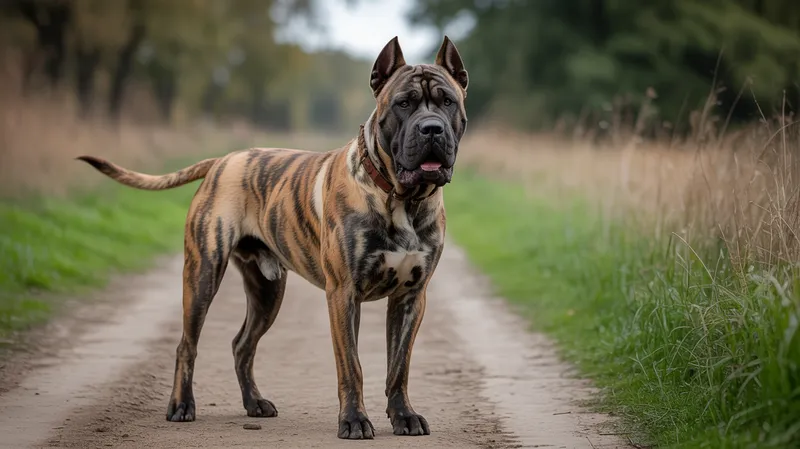
Perro de Presa Canario
Canis lupus familiaris

Meet the Perro de Presa Canario
The Perro de Presa Canario, also known as the Canary Mastiff, is a large, powerful Molosser-type dog breed originally developed in the Canary Islands. Historically, these dogs served as working animals for guarding livestock and property, as well as for herding cattle. They are recognized for their muscular build, broad head, and confident, calm temperament, making them both formidable guardians and loyal companions. With a short, coarse coat and a distinctive brindle, fawn, or black coloration, Presa Canarios are alert, intelligent, and require consistent training from experienced handlers.
Classification
Mammal
Habitat
Domestic, rural, and agricultural environments
Diet
Carnivore
Lifespan
9-11 years
Conservation
Least Concern
Weight
38–59 kg (83–130 lbs)
📖Fascinating Facts
Ancient Origins
The breed's lineage traces back to mastiff-type dogs brought to the Canary Islands by Spanish conquistadors in the 15th and 16th centuries.
Island Symbol
The Perro de Presa Canario is the official animal symbol of Gran Canaria, reflecting its strong historical and cultural ties to the region.
Working Heritage
Historically, these dogs were prized for their abilities in cattle herding and protecting farms from wild or stray animals.
📋Detailed Description
The Perro de Presa Canario is a robust, medium-to-large Molosser breed, notable for its imposing musculature, broad chest, and thick, powerful neck. Adult males typically stand 61–66 cm (24–26 in) at the withers and weigh 45–57 kg (100–125 lb), while females are slightly smaller at 57–62 cm (22–24 in) and 40–50 kg (90–110 lb). The breed’s head is massive and cuboid, with a pronounced stop, well-developed zygomatic arches, and a strong, square muzzle. The ears are typically cropped in traditional settings, though natural, pendant ears are increasingly common. The coat is short, flat, and harsh to the touch, providing protection against the elements and physical encounters. Coloration includes various shades of brindle, fawn, or black, often with a dark facial mask. Presa Canarios possess a calm, confident demeanor, displaying both territorial instincts and a high degree of intelligence. Their movement is agile and purposeful, reflecting their working heritage. Anatomically, they have a deep ribcage and strong limbs, suited for both endurance and sudden bursts of power. Socially, they are known for their loyalty to family and wariness toward strangers, making them exceptional guardians.
💡 Did you know?
Despite their imposing appearance, well-trained Presa Canarios can be gentle and affectionate with their families.
🔬Research & Sources
Wikipedia Summary
The Presa Canario is a Spanish breed of medium-sized dog of mastiff or catch dog type. It originates in the Spanish autonomous community of the Canary Islands, and is found mostly in the islands of Gran Canaria and Tenerife. It was formerly known as the Dogo Canario. It was traditionally used as a guard dog, as a herding dog for both sheep and cattle, and for dog-fighting, which was legal in Spain until 1936 and may have continued clandestinely thereafter.
Last Modified: 5/26/2025
🎭Behavior & Social Structure
Presa Canarios exhibit a stable, self-assured temperament, characterized by vigilance and a strong protective drive. They are highly territorial and form close bonds with their household, often displaying aloofness or suspicion toward unfamiliar people or animals. Historically used as catch dogs, they retain a strong prey drive and may attempt to control or herd other animals. Feeding behavior is typical of large carnivorous breeds, requiring a diet rich in animal protein and moderate fat. Daily routines include regular patrols of their territory, alert posturing, and a preference for structured activities. Social interactions are hierarchical; they respond best to clear leadership and consistent training. While generally calm indoors, they require regular mental and physical stimulation to prevent boredom-related behaviors such as destructiveness or excessive barking. Early socialization is crucial to moderate their natural assertiveness and ensure compatibility with other pets and children.
👶Reproduction & Life Cycle
The breed reaches sexual maturity between 12 and 18 months, with females typically coming into estrus twice yearly. Mating is usually managed by breeders to ensure genetic diversity and health. The gestation period averages 63 days, after which litters of 7–10 puppies are common, though litter size can vary. Females exhibit strong maternal instincts, providing intensive care for the first three weeks postpartum, including nursing, grooming, and thermoregulation. Weaning begins at around four weeks, with puppies gradually introduced to solid food. Responsible breeders emphasize early socialization and health screening for hereditary conditions such as hip dysplasia. There is no distinct breeding season, as domestic dogs can breed year-round, but reputable breeders may time litters for optimal puppy development and placement.
🛡️Adaptations & Survival
Physically, the Presa Canario’s dense musculature, thick skin, and robust skeletal structure are evolutionary adaptations for subduing livestock and deterring predators or intruders. The short, coarse coat offers protection from the subtropical climate of the Canary Islands while minimizing overheating. Their pronounced jaw strength and broad skull enable a powerful bite, essential for their historical role as catch dogs. Behaviorally, their heightened territoriality and acute senses of hearing and smell are specialized for guarding and early threat detection. Their intelligence and trainability are adaptive traits for working alongside humans in complex tasks such as herding, guarding, and property protection.
📚Research Sources
🎨Cultural Significance
The Presa Canario holds a prominent place in the cultural heritage of the Canary Islands, symbolizing strength, resilience, and loyalty. Historically, they were indispensable to rural communities for livestock management and property protection. The breed is featured in local folklore and is an emblematic animal of the region. While dog fighting was once a part of their history, modern efforts focus on promoting the breed’s positive attributes as a guardian and family companion. The Presa Canario is recognized by the Real Sociedad Canina de España and the Fédération Cynologique Internationale, reflecting its national and international significance.
🔬Recent Research & Discoveries
Recent genetic studies have clarified the Presa Canario’s ancestry, revealing contributions from indigenous Canary Island dogs and imported mastiff breeds during the Spanish colonization period. Ongoing research focuses on breed-specific health screening, particularly for orthopedic and cardiac conditions. Behavioral studies highlight the importance of early socialization and structured training in mitigating aggressive tendencies. Conservation efforts emphasize maintaining genetic diversity and promoting responsible breeding practices. The breed is also being studied for its potential roles in therapy and law enforcement due to its intelligence and trainability.
🎥Wildlife Videos

Presa Canario The Rise, Fall, and Revival of a Majestic Breed
This documentary delves into the fascinating history of the Presa Canario dog breed. Discover the socio-economic changes, shifts ...
GSD

Presa Canario - walks in the nature
A short hike with the dogs. One is a 2 year old male and the other 9 month old female. Both Rey Gladiador.
Rey Gladiador

Presa Canario document... lazy times - water dogs
A short video of Presas on a walk, playing and having fun. A vid also made for fun so hope you enjoy and forgive me my shaky ...
Rey Gladiador

Reverse Brindle Presa Canario out for a nature walk through the woods
Massive Mastiffs

CoCo-Janel the Presa Canario - Exploring Bear Mountain in Evergreen, CO (part 2)
The exploration continues as the fog rolls through the valley between Bear Mountain and Mount Evans in Evergreen, CO. CoCo is ...
Scott Verti

Most dangerous and powerful dog in the World (Peru de Presa Canario Peru) Presa Canario Compilation
It is the animal symbol of the island of Gran Canaria. The Perro de Presa Canario or “Canary Dog” is a large-size dog with a thick ...
Universe Unique Animals
🌍Habitat Information
The Perro de Presa Canario typically inhabits Domestic, rural, and agricultural environments environments. Perro de Presa Canarios have adapted to their environments with specialized features and behaviors.
Primary Habitat:
Domestic, rural, and agricultural environments
More detailed habitat information will be available soon.
🛡️Conservation Status
The Perro de Presa Canario is currently classified as Least Concern. Conservation efforts are crucial for preserving this species for future generations.
Common Threats:
- 🏠Habitat loss and fragmentation
- 🌡️Climate change impacts
- 🎯Hunting and poaching
- 🏭Human-wildlife conflict
⚠️Threats & Conservation Challenges
While the global population of Presa Canarios is stable due to active breeding, the breed faces several challenges. Urbanization and changes in agricultural practices have reduced demand for traditional working dogs, leading to a shift toward companion and protection roles. In some countries, the breed is subject to breed-specific legislation due to concerns about aggression, often stemming from improper training or irresponsible ownership. Health challenges include a predisposition to hip and elbow dysplasia, entropion, and certain cardiac conditions. Unscrupulous breeding for size or aggression can exacerbate these issues. Conservation of genetic diversity and responsible ownership are ongoing priorities among breed clubs and enthusiasts.
🔬Scientific Classification
Scientific Name
Canis lupus familiaris
Classification Hierarchy
🔍 About Taxonomic Classification
Taxonomic classification is a hierarchical system used by scientists to classify and organize living organisms based on shared characteristics and evolutionary relationships.
The system moves from broad categories (Kingdom) to increasingly specific ones, with each animal's scientific name typically consisting of its Genus and species.
📝Community Notes
Share your observations and insights about the Perro de Presa Canario with our community of wildlife enthusiasts.
Join Our Community
Sign in to share your observations and connect with fellow wildlife enthusiasts.
Sign In to ContributeNo community notes yet
Be the first to share your observations about the Perro de Presa Canario!
Explore Perro de Presa Canario
Select a tab above to learn more about this amazing animal.
📸Photo Gallery
No photos available for this animal yet.
🌟Discover More Wildlife
Continue your journey of discovery with more fascinating animals from our database
